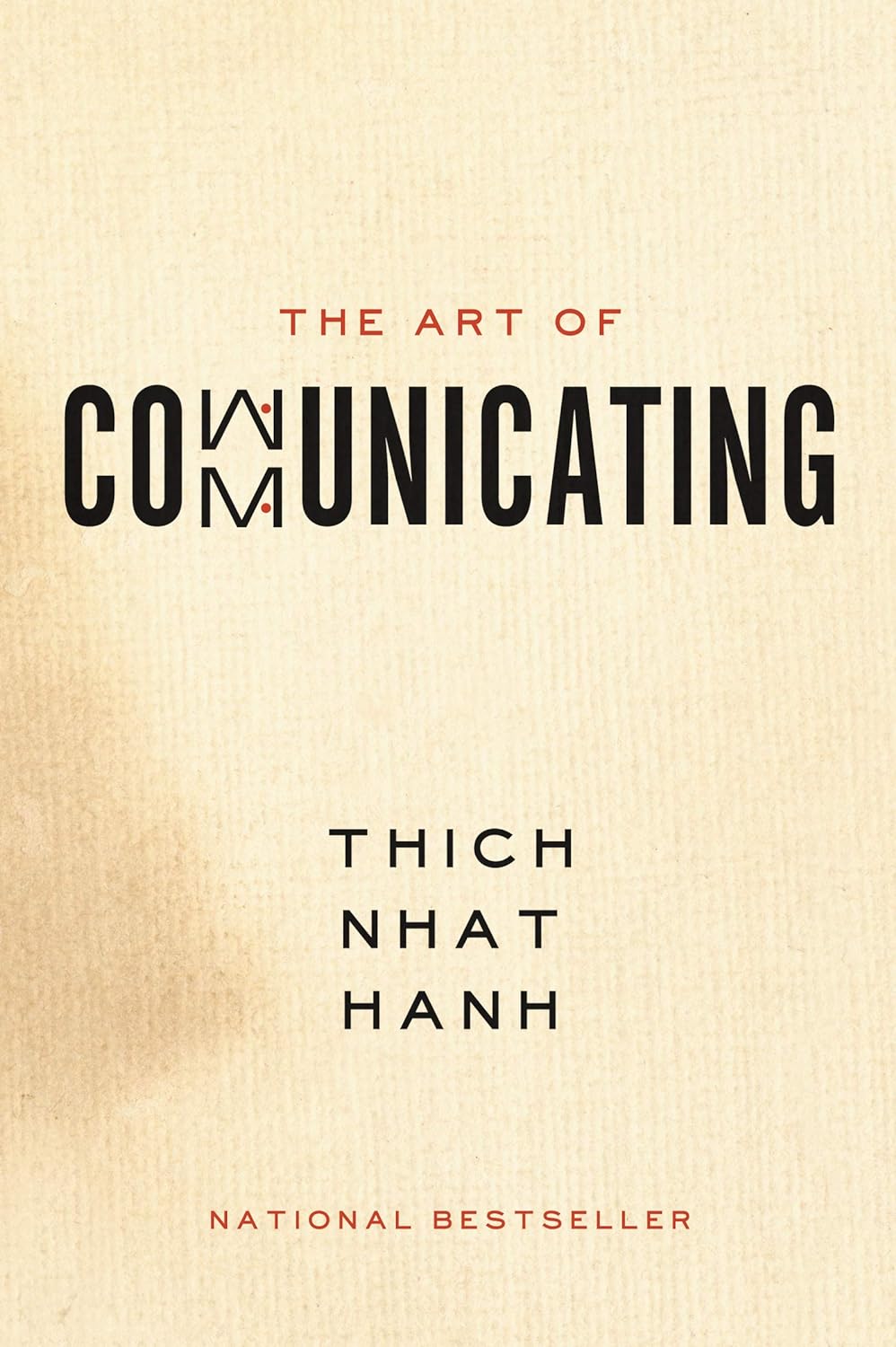Mindful Listening
In the enlightening book "The Art of Communicating," Thich Nhat Hanh unveils the transformative power of mindful listening, a practice that not only enhances our conversations but also deepens our relationships. Mindful listening is about being fully present. It’s not merely about hearing words, but about tuning into the emotions and experiences behind those words. This attentiveness allows us to connect truly and compassionately with the speaker, creating a space of trust and understanding.
Thich Nhat Hanh eloquently explains, “Listening is a very deep practice... you have to empty yourself. You have to leave space in order to listen... especially to the people we think are our enemies — the ones we believe are making our situation worse.” This quote underscores the essence of mindful listening — it’s about setting aside one’s own thoughts and judgments to fully receive the message of another.
This profound approach does more than facilitate clear communication; it acts as a bridge to healing. When we listen mindfully, we give others the precious gift of being heard and understood. It's a practice that not only resolves conflicts but also fosters an environment where compassion and empathy flourish.
By embracing mindful listening, we open ourselves to truly hearing what’s being communicated, which in turn enriches our interactions and nurtures our connections. Dive into the wisdom of Thich Nhat Hanh and transform how you communicate, one mindful moment at a time.
Mindful Speaking
In "The Art of Communicating," Thich Nhat Hanh unveils the transformative power of speaking with awareness and intention. Mindful speaking is about using words that nurture and heal, not only in our relationships but within ourselves. Hanh eloquently states, "Words can travel thousands of miles. May my words create mutual understanding and love. May they be as beautiful as gems, as lovely as flowers."
This concept urges us to speak with love and consideration, choosing words that reflect our true intentions and convey our messages clearly. By doing so, we not only enhance our ability to connect with others but also contribute to a more compassionate world. Every word you utter can be a gift or a barrier; mindful speaking helps ensure it's always the former.
Hanh guides us through the art of crafting our conversations as if they were precious artworks, emphasizing that what we say and how we say it can profoundly impact the listener's heart and mind. As he notes, "Speaking kindly is a habit that we can develop over time. It requires practice, patience, and a heart full of love."
Adopting this practice means being fully present during conversations, ensuring that empathy and understanding are at the forefront. It's not just about avoiding harm but actively contributing to the well-being of those we communicate with. Through mindful speaking, we open doors to deeper connections and genuine understanding, transforming everyday interactions into opportunities for growth and connection.
Let the wisdom of Thich Nhat Hanh inspire you to elevate your conversations, making each word count towards building stronger, more loving relationships. As you integrate mindful speaking into your life, you'll discover its power to change not only the way you communicate but also how you view and interact with the world.
Understanding and Compassion
Thich Nhat Hanh unveils the profound impact that understanding and compassion have on everyday conversations and relationships. He persuasively argues that the essence of good communication stems not just from what we say, but from the depth of our empathy and our ability to grasp the emotions and perspectives of those around us.
Thich Nhat Hanh asserts, "Compassion is a verb." This powerful statement encapsulates his belief that compassion is active, not passive. It requires us to engage deeply with others, offering our full presence to their experiences and emotions. By doing so, we foster connections that are not only more meaningful but also more resilient.
One of the most striking aspects the author emphasizes is how understanding can transform conflict into peace. He explains that when we truly understand someone's pain, our natural response is to show compassion. This doesn’t mean agreeing with everything they say, but rather recognizing their humanity and offering kindness instead of judgment.
To cultivate this, Thich Nhat Hanh introduces practical mindfulness exercises that encourage us to listen more attentively and speak more thoughtfully. He provides simple yet effective techniques such as the practice of deep listening — sitting quietly and listening wholly without preparing a response. This practice can lead to more profound interpersonal connections and a greater sense of peace in our interactions.
"Understanding someone’s suffering is the best gift you can give another person," Thich Nhat Hanh writes. This quote highlights the transformative power of empathy in communication. By prioritizing understanding and compassion, we not only alleviate suffering but also open doors to enriched and more fulfilling relationships.
This section of "The Art of Communicating" serves as a reminder that the path to effective communication is paved with the stones of compassion and understanding. It's not just about what we say or how we say it, but about connecting heart-to-heart with those around us. By integrating these practices into our daily lives, we can change not only our conversations but also our connections with others.
The Relationship with Oneself
Discovering the art of communicating with others begins with a profound and joyful journey inward. In "The Art of Communicating," Thich Nhat Hanh unveils the critical importance of nurturing a peaceful and harmonious relationship with oneself as the cornerstone of all external communication. The book beautifully illustrates how self-awareness and self-compassion are not just practices but essential tools for understanding our own thoughts and feelings.
"Listening to yourself is the foundation of true communication," Thich Nhat Hanh writes, encapsulating the essence of effective dialogue with oneself. By engaging in regular self-reflection and mindful meditation, we can learn to listen deeply to our inner voice, acknowledging our needs, desires, and pains without judgment. This practice allows us to address our own sufferings and celebrate our joys, creating a balanced inner world.
Moreover, Thich Nhat Hanh encourages us to cultivate self-compassion, which enables us to forgive and accept ourselves. This acceptance becomes the basis for extending compassion towards others, thus enhancing our interactions. He asserts, "Understanding and love are not two things, but just one." When we understand ourselves, we open the door to understanding others, paving the way for meaningful and loving exchanges.
Through engaging and thoughtful prose, Thich Nhat Hanh guides readers to see that the path to effective communication with the world starts from within. By embracing our own experiences and learning to communicate internally with kindness and clarity, we equip ourselves to share our truths with the world in the most authentic and impactful way. This internal dialogue is not just about self-improvement—it's about transforming every conversation we have, one mindful word at a time.
Healing and Reconciliation
The power of communication is not merely in the exchange of words but in the profound ability to heal and reconcile with those around us. Nhat Hanh eloquently reminds us, "Words can travel thousands of miles. May my words be like gentle rain."
This book teaches us that healing begins with understanding. By embracing compassionate listening, we open the door to genuine empathy. Nhat Hanh describes this beautifully: "Listening is a very deep practice... you have to empty yourself. You have to leave space in order to listen... especially to people we think are our enemies." It’s not just about hearing words; it’s about recognizing the emotions and experiences behind them.
Reconciliation is portrayed not as a single moment of peace but as a continual journey of mutual understanding and respect. The book encourages us to speak with love and intention, ensuring our words reflect our desires for harmony and connection. "The most precious gift we can offer anyone is our attention," Nhat Hanh asserts. When attention is coupled with mindfulness, communication becomes a bridge to healing.
Whether it's a rift in a personal relationship or a misunderstanding within a community, "The Art of Communicating" equips us with the tools to approach conflicts with a heart full of compassion. It’s about more than resolving disagreements; it’s about fostering an environment where everyone feels heard, understood, and valued.
The Use of Technology in Communication
In "The Art of Communicating," Thich Nhat Hanh delves into the profound impact of modern technology on our daily interactions. With a gentle yet persuasive tone, he reminds us that while devices can bridge distances and bring us closer to those far away, they should not replace the warmth of personal, face-to-face exchanges. Hanh asserts, "If we are not mindful, we can get lost in our technology and become less connected to ourselves and others."
Technology offers incredible tools for staying connected, yet Hanh urges us to use these tools wisely. He highlights the importance of conscious engagement when using technology, encouraging us to be present in our digital conversations as if we were face-to-face. "When you love someone, you can bring a lot of happiness to him or her, just by your presence," he writes, suggesting that presence should extend to our digital interactions as well.
Moreover, Hanh addresses the risk of technology becoming a refuge from real-world challenges. He advises against using digital communication as a shield from the discomfort of direct interactions, which can offer deeper healing and understanding. By advocating for mindful usage, Hanh inspires us to rethink how we integrate technology into our lives, ensuring it enhances rather than detracts from meaningful human connections.
Through these insights, Thich Nhat Hanh not only guides us towards more mindful communication but also offers a path to transform our relationships with technology, making each interaction more heartfelt and genuine. Whether we're sending a quick text or video chatting with a loved one, his wisdom encourages us to bring our whole selves to the conversation, fostering connections that are not just digital, but deeply human.

